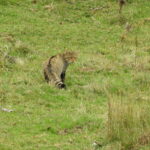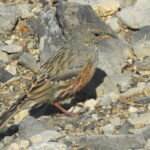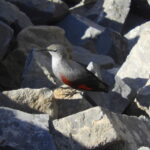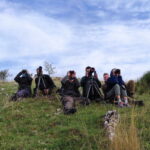Birdwatching and wildlife tours in Spain
Mammal watching in the Cantabrian Mountains
Dates: September 28th-October 4th
The Cantabrian Mountains are one of the last wild places in Europe. They are home of magnificent mammals like European Wildcat, Cantabrian Brown Bear, Iberian Wolf, Southern Chamois and Spanish Ibex to name few. In addition there are many sought-after birds including the stunning Wallcreeper, Lammergeier, Alpine accentor and Alpine Chough among others.
Day 1. Monday 28th September. Santander-Picos de Europa

After having breakfast, we decide to visit a couple of local marshes in Santander while we wait the arrival of Jo and Tim from Majorca. In our first stop we see some waders, mainly Dunlins and Black-tailed Godwits. A solitary Spoonbill stands out in the middle of the mudflats along with Little Egrets. Then, we move to our second locations near the bay of Santander where we find an Osprey and more waders: Bar-tailed Godwits, Whimbrels and Oystercatchers among others. On the walk back to the van, our guide spots some small birds perched on a bush which turn out to be a mix of Whinchats, a Whitethroat and Stonechats.
After picking up the two guests from the airport, we set off towards our hotel in Boca de Húergano. One hour later, we stop to have lunch in Alguilar del Campoo. Later, we continue the journey following different roads and finding a gorgeous Wildcat! That is a good start!
After checking-in the hotel and rest for one hour, we all get into the van and drive around different track to look for Wildcat. Soon, we find one which as we approach, decides to head to the forest . Then, we see a second one, and this one allows us fantastic views. We are doing very well! Our guide Pau says that is quite unusual to have three good wildcat sightings the same afternoon!
Day 2: Tuesday 29th September. Wolf watching in the Cantabrian Mountains

We start the morning early, before the sun rise and are driven in two 4 x 4 vehicles. After parking, we walk the last 350 meters to reach the top of a steep hill. Slowly we made our way and enjoy stunning views of the valleys and mountains. A couple of days before a pack of Iberian wolves was in the area so we set up the scopes and start searching for them. Skylarks and Water pipits are seen. Later, we see our first Reed deer which suddenly runs away, might it have been a wolf? Probably the deer smell the scent of a wolf which was previously in the area as we cannot see any wolves. Around 11:00 we decide to call it a day and get back to the hotel.
Before lunch, we take a stroll and spot some birds including Dipper, Crag martin and Griffon’s vultures. Besides, there are still some butterflies: Yellow clouded, Wall Brown, Long-tailed and Lang’s short-tailed Blues.
At 4:30 we meet again to try to see the Iberian wolves but in a different location which is more accessible. After patiently waiting, we find an adult and 2 young wolves which stay briefly on view. Superb! We have seen the elusive Iberian Wolf!
Day 3: Wednesday 30th September. Alpine birds: Wallcreeper and Lammergeier

The large tropical storm “Alex” is approaching so we change plans and decide to visit today the highest part of the park to search for alpine birds. After driving 1:40 minutes we get to the cable car and soon are on the way. During our first hour the birding is quiet, only spotting Red and Yellow-billed Choughs. We walk towards Pau’s spot where we have lunch while we keep searching the walls and rocks for Wallcreepers. Pau calls out “Wallcreeper” but unfortunately the bird flies off and not everyone sees it. Jo walks around and find another Wallcreeper but when we get there is gone. However, from the same place we get nice views of three Southern Chamois.
On the way back, Linda, Ewan and Pau stay behind. First, they see a juvenile Golden Eagle and a Lammergeier flying around the peaks. Then, half-way to the cable car Pau finds three approachable Alpine accentors followed by a close Wallcreeper spotted by Ewan. Lovely! After having some drinks to celebrate such a wonderful day, we set off to the hotel.
Before dinner, we decide to try again for Wildcats, hoping to get again good views and some photos, and so we did. We spend half an hour watching a beautiful male wildcat hunting voles in the meadows.
Day 4: Thursday 1st October. Iberian Wolves in the Cantabrian Mountains
Today we visit the same spot for Iberian Wolves. The morning is quiet with only a quick sighting so around 11:00 we decide to move to other area where we might see Spanish ibex. Once we arrive, we get a nice view of an adult Golden Eagle and soon we find a female Spanish ibex followed by another.
After lunch and a quick “power nap” we get back to the wolf spot and get this time great views. First Pau spots a Wild boar and then Bernardo sees 2 young Iberian wolves. We have seen before this behaviour. It seems that large male Wild boars follow small wolf packs to make the most of the leftovers. The adult wolves bring food every day and what is not eaten by the youngest is done by the Wild boar. After that, we watch 4 youngsters Iberian wolves chasing one another and playing peacefully. Fantastic!
Day 5: Friday 2nd October. Mammal watching in the Cantabrian Mountains. Somiedo

The storm has arrived in full power. It has been raining all night and still does during the morning, so we decide to change plans and to go to a photography hide where we might get close views of Griffon vultures, and be sheltered from the rain and wind. At the beginning it looks promising with the arrival of corvids and Common buzzard. Unfortunately the weather seems to put off the vultures and they wait patiently in the rocky slopes to dry out the wings. So, after two hours, we move to a rural hotel to have some hot drinks and then drive towards Somiedo. We encounter sleet and snow all the way, are we really in early October?
After having a warm lunch in the hotel, we drive to a local viewpoint to search for Cantabrian brown bear in the mountain slopes. This time of the year they are seen in the open areas feeding on berries and nuts. However, this bad weather will push them to the forest where they are more sheltered. We spend the afternoon watching Southern chamois, Red deer and passerines such as Rock Bunting and Serin.
Day 6: Saturday 3rd October Somiedo – Looking for Cantabrian Brown bears
We try different locations, but the weather seems to be worst that yesterday. On the way to the village of Gua we find a Red squirrel. Around 10:30, we split in two groups: Tim, Ewan and Jesús stay in the viewpoint and the rest of the group go for a walk in Valle del Lago. We take a stroll between the foggy and snowed-capped mountains. We keep busy identifying the numerous passerines that feed in the farmyards: Linnets, Black redstarts, Water pipits and a Marsh tit among others.
After a delicious lunch (fabada asturiana and potes de berzas), we visit a couple more locations where a Bear was spotted by a farmer a couple of days ago. The weather is not helpful, so we only add a Short-toed Eagle to our list.
Day 7: Sunday 4th. October Somiedo-Santander
After breakfast we set off towards Santander which takes us a bit more of 3 hours. We encounter rain and strong winds on the way. Jo, Tim, Linda and Ewan will stay one night in Santander before going home. Malcom, Barbara and Pau will continue their journey south.
Acknowledgements. Birdwatching Spain would like to thank all their guests on this trip for their convivial company throughout the week. The tour was undertaken during very uncertain times, with many Covid 19 restrictions in place, and the fact that it DID run is thanks to the determination of those who participated. Although we fail to find the Cantabrian Brown Bear, partially because of a very bad weather, we did very well in the first part of the trip. The sightings of Wild cat were some of my best; close and long. The Iberian wolf also performed very well with sightings of youngest playing. In addition, we saw some extra mammals such as Spanish Ibex and sought-after bird: Wallcreeper, Lammergeier and Alpine accentor.
The stunning landscape was once again a delight, and was practically bereft of tourists, allowing the group to enjoy a particularly peaceful stay. No doubt we will be back next September! More info in our tour calendar. Check-list available here.